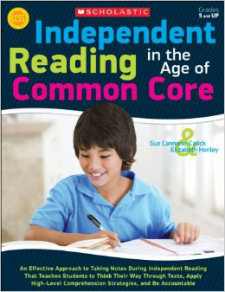SmartNotes for Better Independent Reading
Independent Reading in the Age of Common Core: An Effective Approach to Taking Notes During Independent Reading
By Sue Cannone-Calick and Elizabeth Henley
(Scholastic, 2013 – Learn more)

We’ve all seen it, in every junk-mail book catalog and on every textbook publisher’s website – the one and only book you will ever need to implement the Common Core, fully “aligned” to the standards, complete with a preface written by a CCSS “expert.” Ok, I’m exaggerating here. But, as we all know, publishers have rushed to put CCSS stickers on just about every teaching book written in the past few years, whether that book has anything to do with the Common Core or not.

A helpful strategy to add to independent reading
While the title of the book implies a broad independent reading program to meet all the needs of the Common Core, this book is actually centered around one simple reading strategy within a reading/writing workshop. If you are looking for a handbook on implementing reading workshop or a complete guide to the Common Core reading standards, look elsewhere. (The complete subtitle is the giveaway: An Effective Approach to Taking Notes During Independent Reading That Teaches Students to Think Their Way Through Texts, Apply High-Level Comprehension Strategies, and Be Accountable.)
However, the approach that Cannone-Calick and Henley introduce (which they call “SmartNotes”) is a great technique to include in a well-rounded reading and writing classroom. Essentially, SmartNotes are short notes about a text that include a quote and a short commentary about the quote.
The rationale for the commentary is based on reading comprehension strategies that might be familiar to readers of books like Strategies that Work by Stephanie Harvey and Anne Goudvis, Mosaic of Thought by Ellin Oliver Keene and Susan Zimmermann, and I Read It, but I Don’t Get It by Chris Tovani.
25 mini-lessons to engage students in reading
The idea of SmartNotes builds off of these previous works and adds classroom routines to keep students engaging with these strategies constantly. Cannone-Calick and Henley include 25 mini-lessons that focus on a variety of ways to use SmartNotes, including co-creating SmartNotes with students about whole-class texts and asking students to write their own SmartNotes about their independent reading books.
For example, one mini-lesson entitled “Clarifying Confusion SmartNote Mini-Lesson for Nonfiction” explains how the teacher used an excerpt from Amelia Lost: The Life and Disappearance of Amelia Earhart by Candace Fleming to model how to notice when understanding breaks down while reading a nonfiction text. Then the teacher challenged the students to write their own “Clarifying Confusion” SmartNotes about the books they were reading on their own.
The majority of the book is made up of plans for mini-lessons like this – which, I will admit, became slightly monotonous when I read the book straight through. However, there were several mini-lessons and strategies from this book that I will definitely use, making this a great resource to keep on my shelf.
I probably will not implement every mini-lesson in my classroom, nor will I label what my students and I do “SmartNotes.” But I already have found myself asking my students to do more note-taking and annotating as they read. The authors have sparked my thinking about what I require of my students when reading. Independent Reading in the Age of Common Core is not a must-have for every teacher, but it is a short, easy to use resource that can support and strengthen any middle school teacher’s independent reading instruction.
Tyler McBride recently started his third year of teaching 7th and 8th grade ELA at Greenland Middle School in Arkansas. He is a teacher-consultant with the Northwest Arkansas Writing Project and a board member of the Arkansas Council of Teachers of ELA. His blog, Common Sense in ELA, documents his experiments with workshop teaching. Tyler lives in Fayetteville, Arkansas with his wife, Vasti, their dog (Molly) and two cats (Butter and Popcorn). Follow him @tylerdmcbride



































